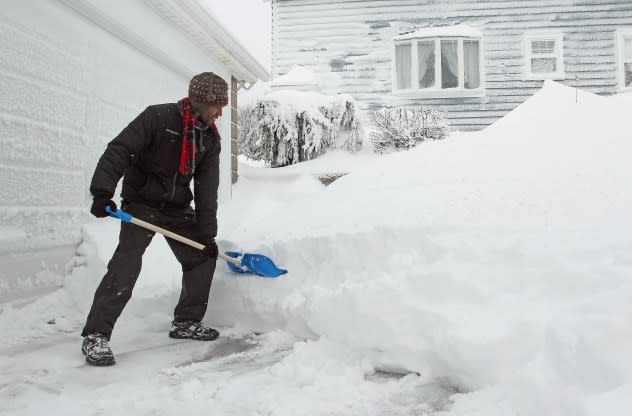How cooking spray and socks can make shoveling snow easier
If done incorrectly, shoveling snow can lead to injury and even death. Not only is shoveling snow a lot of work, but about 100 people in the United States die every winter while shoveling.
Changing the way you shovel can make your cleanup much easier, quicker and save you from a backache. Below are several hacks for shoveling your sidewalk and driveway correctly and efficiently.
 |
Virgel Mahoro uses a shovel to remove a four-foot high snow drift in his driveway, Saturday, Feb. 9, 2013, in Providence, R.I. (AP Photo/Stew Milne) |
Simple things from socks to cooking spray could make a huge difference.
Your equipment can make a huge difference in how easily you can move snow as well as how tough it is on your back and muscles.
There are several ice shovel hand attachments on the market that allow you to attach and remove handles in a spot of your choice to get a better hand position.
 |
Workers clear the sidewalk across from the MBTA station during a snowstorm, Tuesday, March 14, 2017, in Lawrence, Mass. (AP Photo/Elise Amendola) |
Some shovels come with more than one handle, which makes it easier to shovel and break up snow or ice.
Removing stuck snow on your shovel can take a lot of extra time.
To avoid the extra hassle, spray your shovel with cooking spray, spread vegetable oil or coat it in wax. The spray or oil will act as a lubricant, preventing the snow from sticking to the shovel.
 |
A man spraying butter on cooking molds in the kitchen. (Getty Images) |
If the snow begins to stick to the shovel, it is time to reapply the spray or oil. It is best to apply it before every use.
Some say putting socks over your boots helps with traction while shoveling snow.
According to a New Zealand study, socks over shoes surpass shoes over socks for walking on slippery snow or ice.
"Wearing socks over shoes appears to be an effective and inexpensive method to reduce the likelihood of slipping on icy footpaths," the study said. It might also keep your feet warmer.
For this hack to work the snow has to be the perfect consistency. The snow needs to stick, so wet and slushy snow will not work.
If the snow will stick, take a ball of snow and roll it like you would for a snowman. Keep rolling the snowball around your sidewalk or driveway.
 |
Kendall Locke, 18, of Katy, Texas, works on building a snowman on Capitol Hill in Washington, Wednesday, Jan. 21, 2015. Locke is on a school trip and this was the first snow she has seen and the first snowman she has ever made. (AP Photo/Susan Walsh) |
If the ball gets too large and heavy to roll, start the process over again.
To tackle snow with a leaf blower, you will need to use the most powerful blower you can find.
Depending on the power of your leaf blower, it should be able to push aside snow that it is no more than 1 inch thick.
 |
Will Scott uses a blower to remove snow from a parking lot on Wednesday, Feb. 18, 2015, in Nolensville, Tenn. The Tennessee Emergency Management Agency says the state remains in a state of emergency as it deals with more snow, subfreezing temperatures and slick roads. (AP Photo/Mark Zaleski) |
Another important thing to keep in mind when trying to remove snow with a leaf blower is that the leaf blower won't perform well against wet snow.
Also, do not use an electric leaf blower to blow snow. If moisture gets into the motor the machine could shock you.
To avoid shoveling altogether, lay down a tarp to easily pick up and remove after snowfall.
Spread your tarp or plastic sheet over your sidewalk, driveway or even vehicle.
Smaller pieces of tarp might be best if you expect a lot of snow, since smaller sections are easier to move without much effort. Make sure to add rope, twine or string to create handles that will help you move the tarp when it's time.
If the conditions are windy, find something to weigh down the tarp so it doesn't blow away.
If you are like Judy Ross, the woman who went viral for being fed up of shoveling snow, you can buy a heated mat for your driveway, sidewalk or stairs.
The heating element can either be tubes of heated water or electric cables.
You asked, we're answering! Find the answers to our customers top HeatTrak questions! https://t.co/VvLYwTrPhY pic.twitter.com/4mLXqKamFv
— HeatTrak Snow & Ice Melting Mats (@HeatTrak) April 26, 2017
For more safety and preparedness tips, visit AccuWeather.com/Ready.
Want next-level safety, ad-free? Unlock advanced, hyperlocal severe weather alerts when you subscribe to Premium+ on the AccuWeather app. AccuWeather Alerts™ are prompted by our expert meteorologists who monitor and analyze dangerous weather risks 24/7 to keep you and your family safer.







